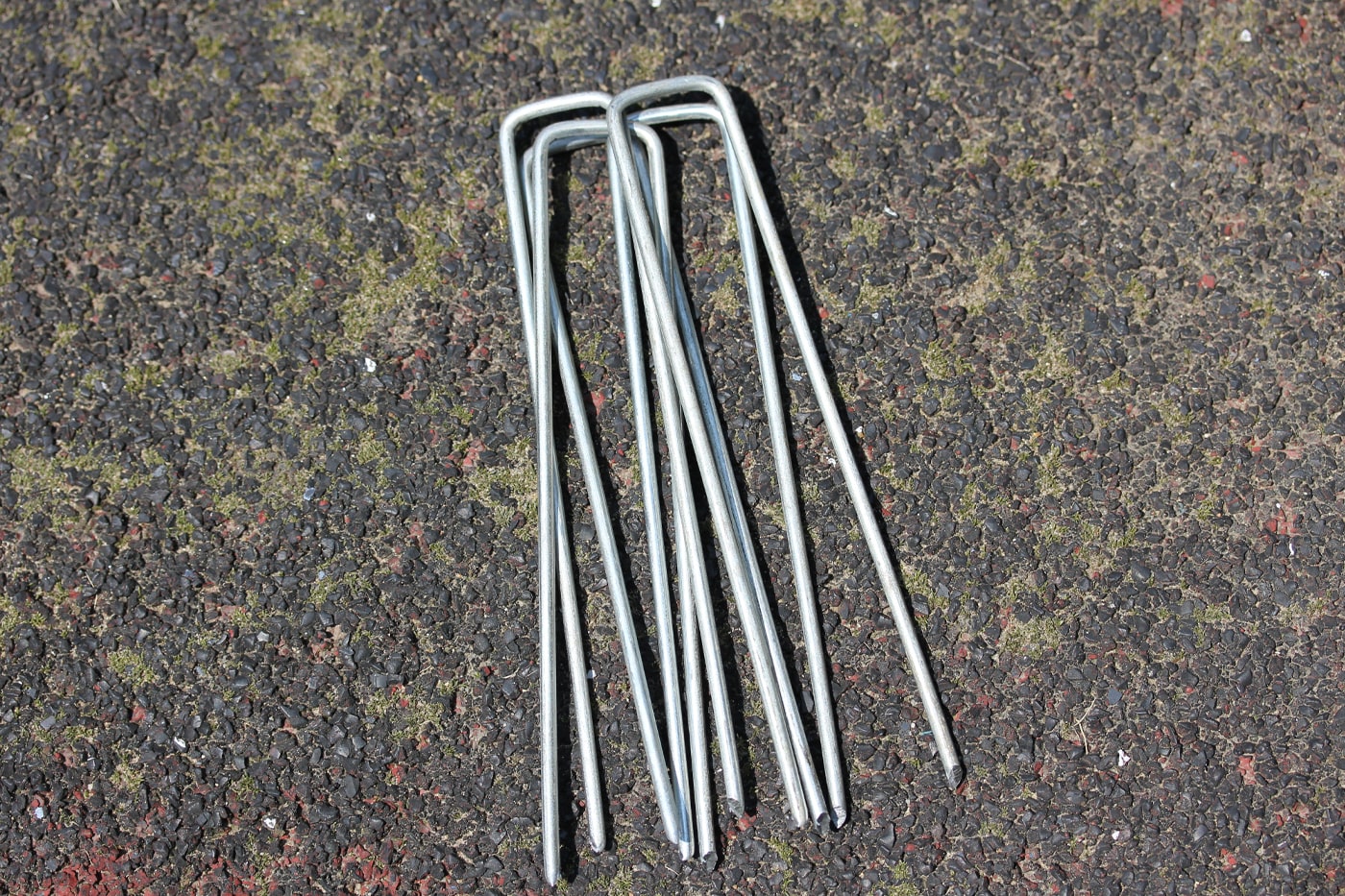Landscape fabric can be used in various applications, most commonly to suppress weed growth. It can minimize soil erosion, insulate the soil by adding a layer of mulch on top of it and install drip irrigation tubing.
When it comes to installation, you can either install the landscape fabric on your own or call a professional to do it for you. Either way, you’ll need landscape staples to set the fabric in place. Depending on the size of the outdoor space being covered, you may need a lot of landscape staples, and having excess is better than being short on pins.
Contents []
What are landscape staples?
Landscape staples are pins made from low carbon, thick steel that holds the landscape fabric in place. It’s typically u-shaped, although some have a circle top. No matter the shape, landscape staples are installed by pounding the pins into the seams of the landscape fabric and through the ground using a rubber mallet to set the landscape fabric in place and prevent the elements from moving the material around.
Apart from setting landscape fabric, landscape fabric pins can be used to secure fake grass, burlap netting, jute netting, and other materials on top of the soil.
How many landscape staples to get?

Calculating the number of landscape staples to get will depend on the size of the outdoor space being covered. You’ll need to calculate about one staple every 8 to 12 inches of landscape fabric.
You will need more staples for soft soil than hard, dry soil because the landscape fabric has to be anchored in place securely. Soft ground tends to move around, so the more staples you use, the better it will be to set the landscape fabric in place. In soft soil, install one landscape staple every 1 foot. On average soils, install one pin every 3 feet. In hard, dry, compacted soil, install 5 staples every 5 feet.
If say, you are installing landscape fabric to a 20 feet long x 5 feet wide garden bed; you’ll use a 3 feet wide landscape fabric; you’ll likely use 20 pins on one side, 20 pins along the center where the material overlaps in sections, and 20 pins along the other side + 3 pins on the last two sides. That’s about 66 pins, so get at least that number, but again, having more pins is better than being short by one or two.
What kind of landscape staples to get?

Landscape staples are identified by gauge, length, width, or thickness. The general rule is to use long landscape staples for soft soils. The loose texture means pins could loosen, so longer staples go deeper into the ground for a more secure hold.
Shorter and wider landscape staples are best for hard, dry, and compacted soils. The thicker, wider pins are more durable than longer yet thinner staples, able to penetrate the soil better without breaking.
As for the gauge or thickness, thin staples have a higher gauge while thick staples have a lower gauge number. Pins with a lower gauge (9 gauge) are less likely to snap or bend during installation. Staples with an 11 gauge are best for average soils, while longer staples that are 9 to 12 inches are best for soft, loose soil. Shorter staples are best for hard, dry soil.
How to install landscape staples?

How to use landscape fabric staples? After assessing how many landscape staples and how much fabric you need to cover your outdoor space, cut the landscape fabric into sections. Roll the landscape fabric, securing the material with pegs so the material won’t move as you staple them in place. Be sure to overlap the edges of the landscape fabric by about 12% so weeds won't grow in between the cut sections of the material.
Do not stretch the landscape fabric even when there’s a dip in the ground. The material must be lying flat, touching the ground at all times, no matter how uneven the ground is. Let the landscape fabric adjust to the contours of the land and never tug. Once the landscape fabric has been laid out, get your rubber mallet and start pounding each staple into the ground.
What’s important is to never skimp on landscape staples because if these were installed too wide apart, the material wouldn’t be as secure. The fabric could move or loosen, eventually sustaining damage from the elements.
What to look for in landscape staples?

The gauge of the staples and the materials are the two things you need to consider when shopping around for landscape staples. Be sure that the gauge or thickness of the pins is suitable for your garden’s soil type. If you’re unsure about the gauge, it’s best to consult with an expert just so you won’t waste money on this product.
Choose landscape staples made from durable, rust-resistant steel. Using galvanized landscape staples like the ECOgardener 8-gauge landscape staples is your best bet if working with hard, compacted soil.
The staples are weather-proof and durable, able to hold the thickest landscape fabric and keep it in place no matter how challenging the landscape situation is. These won’t bend or warp as you fasten them into the ground. The chisel point is sharp, able to easily penetrate the landscape fabric and hard-packed soil.
For more landscape fabric products and other gardening essentials, check out our online store here.



